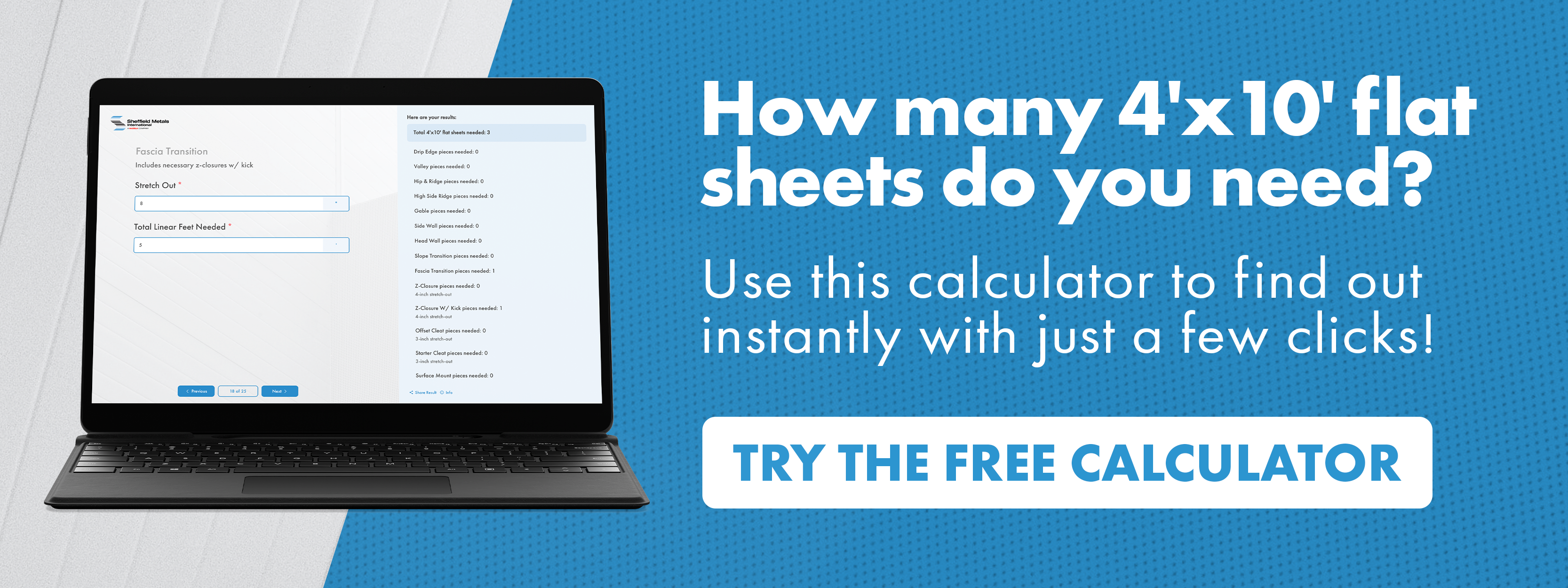Installing a metal roof effectively starts with the foundation. If the foundation is solid, then you can provide all the best benefits of a metal roof — impressive durability, sleek aesthetics, and longevity. But what happens if your project’s plywood decking is rotting away or damaged? What steps can you take to safely inspect damage, remove the affected decking, and replace it?
Sheffield Metals International (SMI), a leading provider of bare metal coils and sheets, has been working in the metal roofing industry for decades. We’ve helped contractors find the right information to guide them through their projects and know what it takes to install a long-lasting metal roof.
In this article, we’ll provide an in-depth view of how to remove and replace plywood decking, including:
- How to safely inspect plywood roof decking for replacement
- How to effectively replace plywood decking
- How to know what type of plywood to use for replacement
- How to account for added costs of removing and replacing plywood
- Differences between residential and commercial projects when removing plywood
By the time you’re done reading, you’ll have a better idea of how to best remove and replace plywood decking for your metal roofing project. Note that this article is intended only for residential projects — commercial projects will require much more precision, as they may include weathertight warranties, something we’ll touch on later.
How to Inspect Plywood Roof Decking for Replacement

The first thing you’ll want to do is inspect your roof decking. If you’re planning to install a metal roof on a house that has shingles, it’s recommended to tear the original shingles off to see what you’re working with on your decking — otherwise, there’s no way of knowing if you have damage underneath.
Look for Damage

Metal roofs are expensive and valuable products that can service customers for years to come — but only if the proper precautions are taken before installation even begins. In some cases, to do a job right, it makes sense to tear off the shingles and do a plywood inspection.
Inspecting and walking on a roof that needs or potentially needs plywood replaced can be one of the most hazardous aspects of roofing and should be treated as such. If there is any concern about the structural soundness of the roof to bear the weight of the inspector, do not attempt to walk on the roof. Instead, use a ladder and inspect the perimeter. Check the underside via the attic if possible.
During inspections, you may come across many different forms of damage on plywood, including:
- Mold and mildew
- Water damage in valleys
- Rot
- Loose nails and fastenings
Metal roofs have engineered systems for panels, clips, and fasteners to ensure durability and protection from weather factors like wind uplifts and even hurricanes.
However, all of this precise engineering will only be as effective as the foundation it’s sitting on. If your plywood decking is bad, it could jeopardize the whole roofing system. A bad enough storm could even pull up the plywood decking with the roof itself if it’s not secure.
Make Sure the Roof Is Level

During inspection, you’ll also want to make sure that the roof is on plane, or flat and level throughout. You’ll likely be able to see this with an eye test — walk around the home and examine the ridges and roof line. This simple view should tell you a lot about the roof plane. If you can’t see abnormalities with the naked eye, then your deck might be fine. To take it a step further, you can run a string line from eave to ridge and look for any low or high spots in the decking.
If you do see large dips or malformations in the roof, you’ll want to address them. If you don’t deal with these, they could disrupt the aesthetics of the new roof, leading to oil canning in the future and functionality issues with clips.
To level the roof, you’ll need to tear the plywood up and find the correct measurements to get your decking back on plane.
Be sure to examine your decking, look for damage or vulnerable points, and then make the proper repairs and replacements to stabilize the foundation of your metal roofing project.
How to Replace Plywood Decking

Replacing plywood is not an easy job — it’s labor-intensive, and often you’ll have to use a variety of different tools, including hammers, pitchforks, and shingle removers, and also enlist the help of two or three other workers to pry up sheets. Some plywood decks, and even some specific parts of the decking, may be more challenging to pull up than others, while others may come up quickly.
While you’re prying these plywood decks up, safety is critical. Be sure you’re wearing gloves and safety glasses, and always keep safety precautions in mind.
The new sheet you put on should not be overly tight. You should leave a small gap; typically, 1/8” is suitable for any plywood that needs to expand or move. Leaving that small gap will prevent any future issues of plywood cramming together. How much space you leave will also be dictated by plywood stagger patterns, clip spacing requirements, and local building codes.
What Type of Plywood Should You Use?

It’s best to refer to your local building codes to know what type of plywood decking to use for replacement. You’ll need to know their minimums and what type of plywood that area prefers. You’re going to have a nail pattern you want to stick with. Typically, you’ll have a 6” nailing perimeter with a 12” field. The specific engineering of the system will also require certain thicknesses of plywood.
Every location is different — you’re dealing with varying winds, weather conditions, and environmental factors, so check with your local building codes and make sure the plywood you’re putting on, along with the nail and fastening patterns you’re using, is something they would recommend and that would meet code.
If your project requires an engineered roof system, there will be a fastening pattern for the plywood in the engineered report.
How Do You Account for the Added Costs of Removing and Replacing Plywood?

Removing and replacing plywood might not be something a homeowner expects during their metal roof installation. And if you do have to replace plywood at some point during the job, it might come as a surprise to the customer when you outline the final costs. To prevent any issues arising from the added costs of removing and replacing plywood decking, consider these strategies:
- Include replacing plywood decking costs in the initial quote: It’s a good idea to include those added costs in your initial project quote. How you price this is based on your preference. For example, it could be a certain amount per sheet of plywood decking to replace. That way, if you have four sheets of plywood you need to replace, it’s not a surprise to the homeowner, and there isn’t an added cost seemingly out of nowhere.
- Explain the added costs to the homeowner: Outlining the added costs of replacing plywood in the quote can be paired with a simple conversation with the homeowner. You can explain that you might need to replace plywood decking in some situations to ensure the roof will be installed effectively. Having discussions before work even begins will set your project on the right track and also open the lines of effective communication between you and the homeowner.
Conveying your message to the homeowner and being transparent with any added costs is integral to completing a quality metal roofing job. For those working on commercial projects, you’ll likely encounter other, more complex challenges.

How Do Commercial Jobs Differ for Removing Plywood Decking?
Commercial projects mainly differ because you could be dealing with weathertight warranties, which act as guarantees from installers and manufacturers that the roof will not leak. This raises the bar substantially when it comes to requirements — you’ll be working with specific engineering, unique details, and projects will be inspected during installation. You’ll be required to meet all of the necessary requirements for that particular panel and comply with all the weathertight warranty specifications.
These weathertight warranties will impact what plywood you’re using and the specific thickness. Metal roofing suppliers like Sheffield Metals will supply specific engineering that’s gone through rigorous testing to ensure its capabilities under pressure. When installing, you’ll have to install clips at certain distances to meet that engineering.
For commercial projects, you want to make sure you’re staying in close contact with your representative and metal roofing supplier to ensure your plywood, clips spacings, and details all meet the weathertight warranty requirements of your project.
Where Can I Find More Information on Metal Roofing Installation?

While removing and replacing plywood decking can be an added obstacle for metal roof installations, it’s ultimately an integral part of the process that will protect the foundation of a metal roof. Following best practices, taking safety precautions, and communicating with your customer about any added costs will be very helpful.
Now, you may be looking for additional resources on installing a metal roof or could be wondering whether it’s possible to put a metal roof over a shingle roof. You can visit our Metal Roofing Learning Center to find additional resources on these topics.
If you’re looking for direct advice from metal roofing experts on replacing plywood decking or need materials for your next project, reach out to the Sheffield Metals team today.
